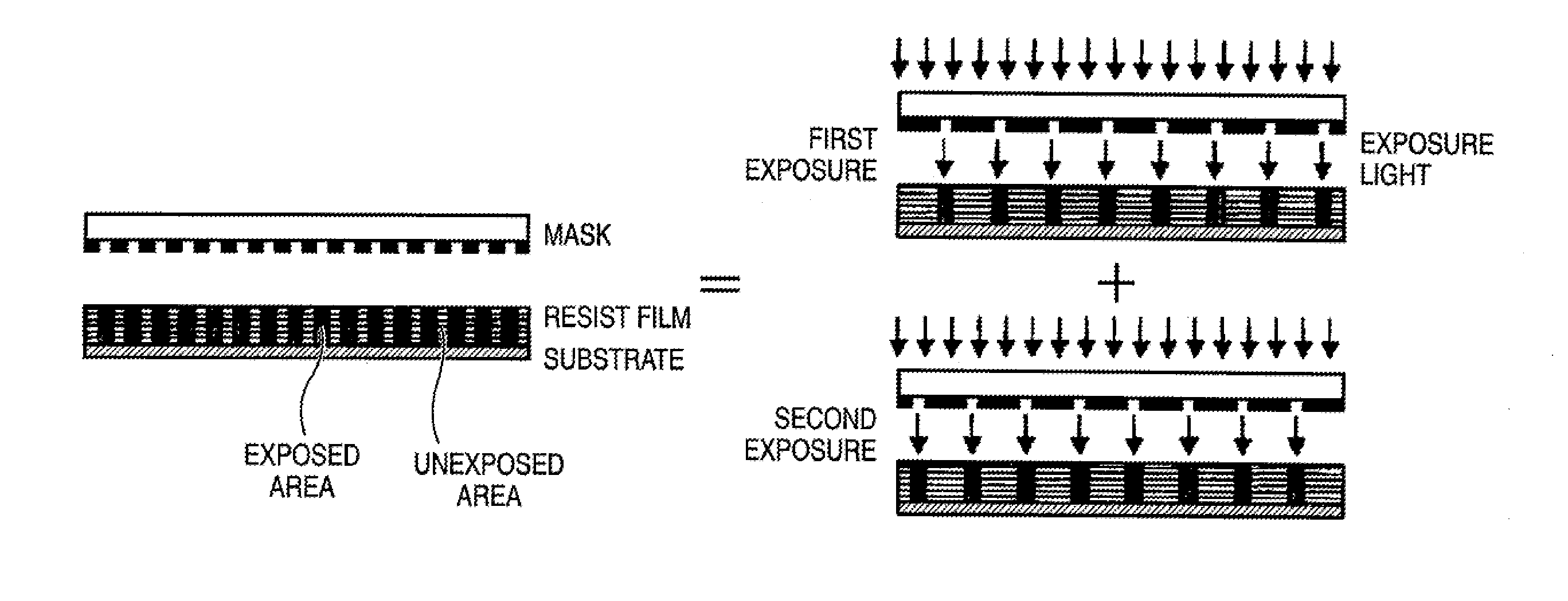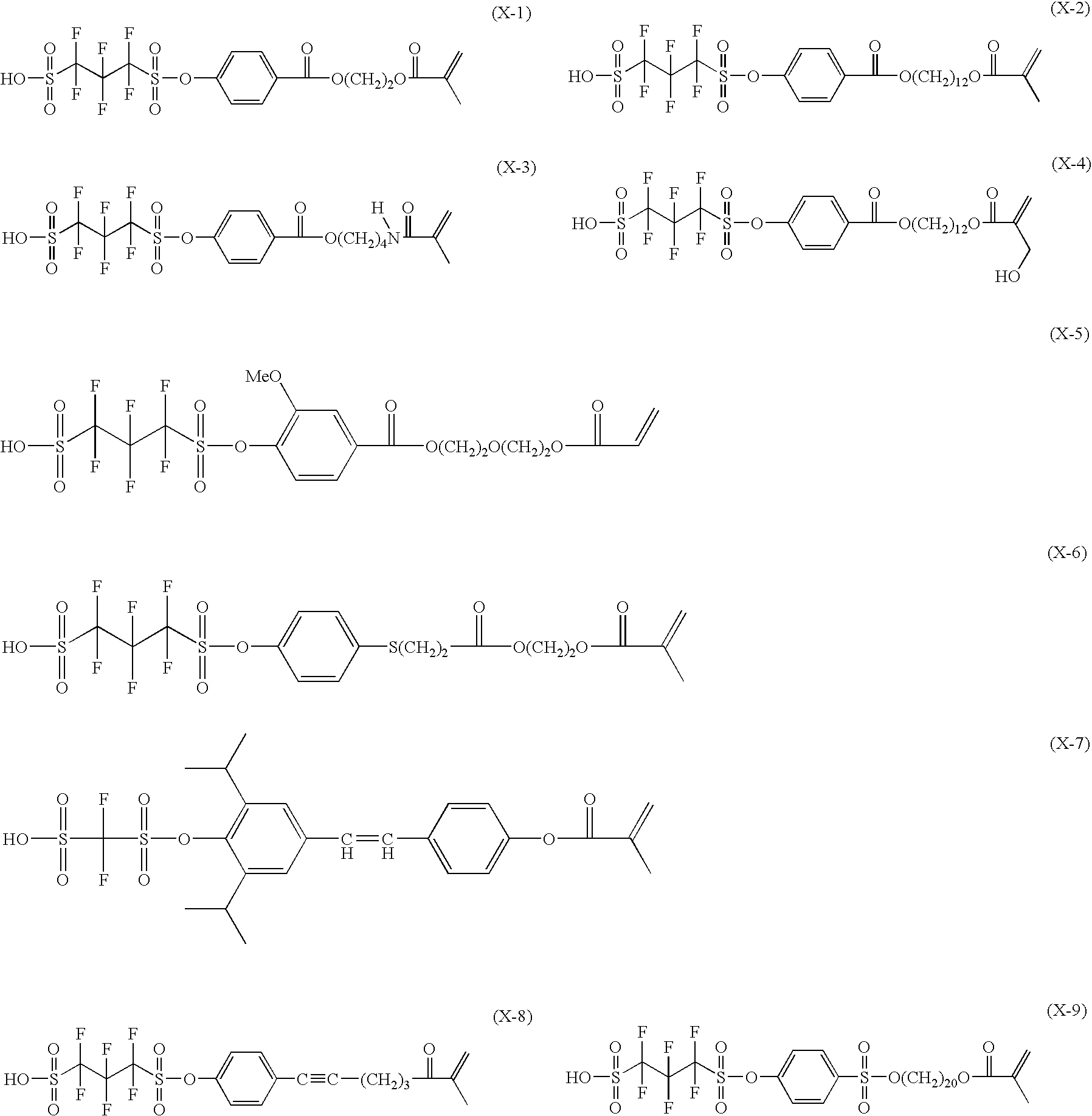Photosensitive composition, pattern forming method using the photosensitive composition and compound for use in the photosensitive composition
a technology of composition and compound, applied in the field of composition and pattern forming method using the photosensitive composition and compound for use in the photosensitive composition, can solve the problems of component adversely affecting the immersion liquid bleed out from the resist layer, the environmental safety and refractive index has not yet been found, and the resist layer deteriorates. , to achieve the effect of reducing pattern collapse and development defect, good performance and good performan
- Summary
- Abstract
- Description
- Claims
- Application Information
AI Technical Summary
Benefits of technology
Problems solved by technology
Method used
Image
Examples
synthesis example 1
Synthesis of Compound A-2
[0514]6.32 Gram of 4-hydroxybenzoic acid was dissolved in 100 mL of N-methylpyrrolidone, 6.96 g of diaza(1,3)bicyclo[5.4.0]undecane was added thereto, and the resulting mixture was cooled to 0° C. in a nitrogen stream. Thereto, 50 mL of an N-methylpyrrolidone solution having dissolved therein 15 g of 1,12-dibromododecane was added dropwise over 0.2 hours, and the obtained reaction solution was stirred at 0° C. for 2 hours and further stirred at 50° C. for 4 hours. After adding 200 mL of ethyl acetate, the organic layer was washed, in sequence, twice with an aqueous saturated sodium hydrogencarbonate solution and twice with water and dried over sodium sulfate. The solvent was concentrated, and the residue was purified by column chromatography (SiO2, hexane / ethyl acetate=2 / 1) to obtain 10.2 g of 12-bromododecyl 4-hydroxybenzoate as a transparent oil. Thereafter, 4.62 g of the oil and 3.79 g of 1,1,2,2,3,3-hexafluoropropane-1,3-disulfonyl difluoride were dissol...
synthesis example 2
Synthesis of Compound A-18
[0515]12.4 Gram of 4-(2-aminoethyl)phenol and 9.15 g of triethylamine were dissolved in 100 mL of N-methylpyrrolidone, and the solution was cooled to 0° C. in a nitrogen stream. Thereto, 9.45 g of methacryloyl chloride was added dropwise over 0.2 hours, and the obtained reaction solution was stirred at 0° C. for 1 hour and further stirred at room temperature for 4 hours. After adding 500 mL of ethyl acetate, the organic layer was washed, in sequence, twice with an aqueous saturated sodium hydrogencarbonate solution and twice with water and dried over sodium sulfate. The solvent was concentrated to obtain 12.2 g of N-(4-hydroxyphenethyl)methacrylamide as a brown oil. Thereafter, 7.49 g of the oil and 11.5 g of 1,1,2,2,3,3-hexafluoropropane-1,3-disulfonyl difluoride were dissolved in 100 mL of THF, and the resulting solution was cooled to 0° C. Thereto, 4.43 g of triethylamine was added dropwise over 0.3 hours, and the obtained reaction solution was stirred a...
synthesis example 3
Synthesis of Compound A-46
[0516]6.95 Gram of N-(4-hydroxyphenethyl)methacrylamide and 10.7 g of 1,1,2,2,3,3-hexafluoropropane-1,3-disulfonyldifluoride were dissolved in 80 mL of THF, and 80 mL of triethylamine was added thereto. The resulting mixture was stirred at 50° C. for 2 hours, and 5.56 g of trifluoromethanesulfonamide was added thereto. The mixture was further stirred at 80° C. for 4 hours. After adding 200 mL of ethyl acetate, the organic layer was washed, in sequence, twice with dilute hydrochloric acid and twice with water and dried over sodium sulfate. The solvent was concentrated, and the brown oil as residue was dissolved in 200 ml of methanol. Thereto, 10 g of sodium hydrogencarbonate as solid was added, and the mixture was stirred at 50° C. for 4 hours. After adding 200 mL of ethyl acetate, the organic layer was washed, in sequence, twice with saturated brine and twice with water and dried over sodium sulfate to obtain 12.2 g of N-(trifluoromethanesulfonyl)-1,1,2,2,3...
PUM
| Property | Measurement | Unit |
|---|---|---|
| refractive index | aaaaa | aaaaa |
| refractive index | aaaaa | aaaaa |
| refractive index | aaaaa | aaaaa |
Abstract
Description
Claims
Application Information
 Login to View More
Login to View More - R&D
- Intellectual Property
- Life Sciences
- Materials
- Tech Scout
- Unparalleled Data Quality
- Higher Quality Content
- 60% Fewer Hallucinations
Browse by: Latest US Patents, China's latest patents, Technical Efficacy Thesaurus, Application Domain, Technology Topic, Popular Technical Reports.
© 2025 PatSnap. All rights reserved.Legal|Privacy policy|Modern Slavery Act Transparency Statement|Sitemap|About US| Contact US: help@patsnap.com



